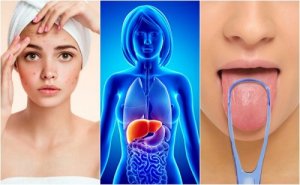7 Warning Signs that Indicate Trouble in the Liver


Reviewed and approved by the doctor Maricela Jiménez López
The problem is that bad lifestyle habits and exposure to polluted areas deteriorate the liver and lead to several problems.
The organ ends up reducing its capacity to purify the body and, little by little, it gives off warning signs to tell us it’s not healthy.
The biggest problem is that many people ignore the situation and they don’t respond to the problem in time because they confuse the signs with other illnesses.
This is why we want to talk about these 7 warning signs that indicate trouble in the liver. Watch out for them!
Warning signs that indicate trouble in the liver
1. Unexplainable weight gain

Excessive build-up of toxins in the liver interferes with its capacity to help digest fats. This interference affects the process that removes fats from the body.
This condition makes it difficult to maintain a healthy weight, even if you’re following a diet low in calories.
The body stores toxic fat cells and later distributes them throughout the body because the organ is unable to process them.
Also read: How Much Do You Need To Walk Every Day to Lose Weight?
2. Chronic fatigue
A constant feeling of tiredness, or experiencing the symptoms of chronic fatigue, are also signs that the liver is overwhelmed with toxins.
This combination of reactions occurs because the liver’s inability to complete its functions leads to metabolic complications.
It can lead to pain, inflammation, and other problems that reduce our ability to complete everyday tasks.
3. Sweating and body odor

Although many of us don’t know it, the liver’s functions are also connected to body temperature and odor. The difficulties brought on by toxin build-up can cause excessive sweating and unpleasant body odors.
Sweating and odors result from the body’s quest to regulate temperature because it heats up when it fights toxic agents and bacteria.
4. Cystic acne
A sudden acne breakout can indicate a hormonal problem or a failure in the hepatic system. If you have big and inflamed pimples that tend to scar, it might have something to do with a liver malfunction.
In general, those who suffer from this skin problem usually have difficulties controlling their acne due to toxin retention in their liver. You need to find a way to purify the liver in order to cure it completely.
5. Allergies, one of the signs that indicate trouble in the liver

Because toxins reduce the liver’s ability to purify itself, it can result in an autoimmune reaction that causes allergic reactions.
Antibodies detect when something isn’t right and immediately attack the allergens that affect the body.
If the organ begins to fail and sees itself unable to carry out this function, the body stores too much histamine. This leads to consequences like:
- Sensation of inflammation.
- Itching all over the body.
- Headaches.
- Nasal congestion.
Visit this article: How to Control Allergies with Natural Antihistamines
6. Gastroesophageal reflux
Gastroesophageal reflux may be a common occurrence for indigestion and stomach problems, but it can also be a sign of a liver problem.
When the organ fails to function properly, the blood’s pH levels shift and cause too much acidity. These pH levels irritate the stomach lining and weaken the sphincter, which traps acidic juices.
7. Bad breath

When bad breath turns into a persistent problem in spite of having good oral hygiene, it might have something to do with the liver. Bad breath could be the result of complications in the processing of toxins that the liver needs to filter out of the blood.
When the liver slows down, waste builds up in its tissue and, in many patients, causes an unpleasant mouth odor.
It can even leave a light metal taste in the mouth if the liver is overwhelmed with heavy metals.
Do you have any of these signs that indicate trouble in the liver? If so, contact your doctor to find out if you have a liver problem. Furthermore, improve your dietary habits and try to consume drinks and foods that help the detoxification process.
All cited sources were thoroughly reviewed by our team to ensure their quality, reliability, currency, and validity. The bibliography of this article was considered reliable and of academic or scientific accuracy.
- Castaing, D., & Veilhan, L. (2006). Anatomía del hígado y de las vías biliares. EMC – Técnicas Quirúrgicas – Aparato Digestivo. https://doi.org/10.1016/S1282-9129(06)47846-6
- Gomesda-Silveira, V., & Ribeiro-Filho, J. (2006). Anatomia y Fisiologia Hepatica. El Transplante Hepático En El Comienzo del Milenio. https://doi.org/10.1002/bjs.5652
- Porter, L. K. (2012). El Alcohol y el Hígado. HCSP. https://doi.org/10.1016/j.buildenv.2011.12.018
- Morillas, R., Planas, R. (2010). Hepatitis autoinmune. Hígado. https://doi.org/10.1016/B978-84-458-1567-0.50235-6
This text is provided for informational purposes only and does not replace consultation with a professional. If in doubt, consult your specialist.








